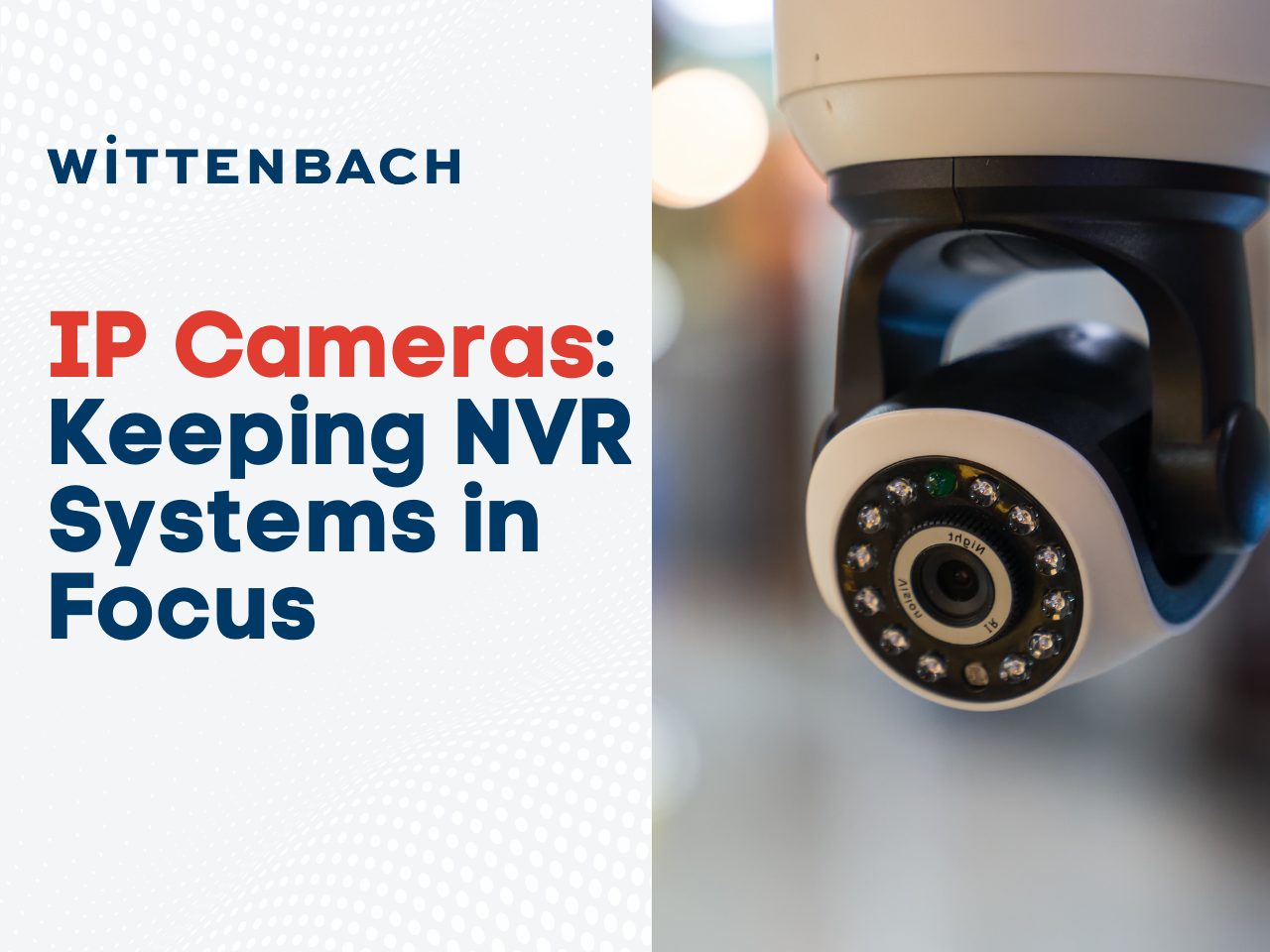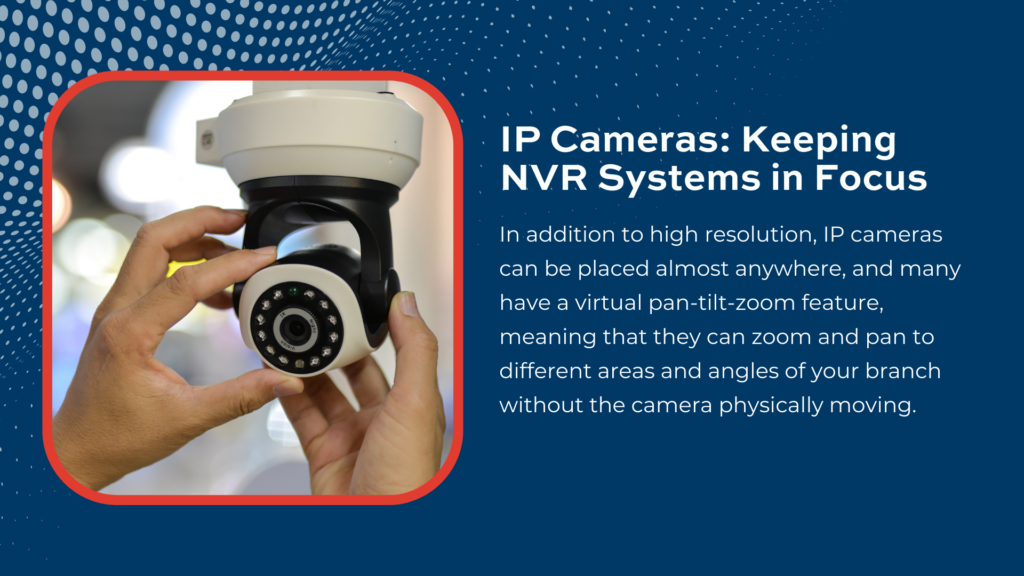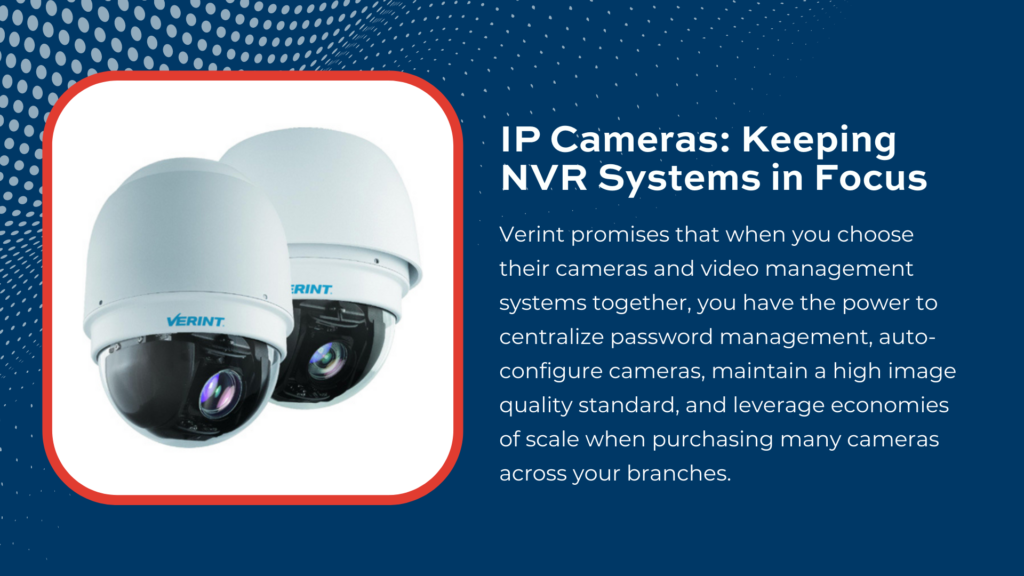When your financial institution invests in electronic security, a Network Video Recorder (or NVR) is the modern choice for surveillance. The NVR is the digital answer to its less advanced predecessor the Digital Video Recorder (or DVR). Systems such as the Verint EdgeVR can protect your bank, credit union, or business—and the accompanying high-resolution Internet Protocol or IP cameras can be placed virtually anywhere.
How do NVR systems protect your branch or business?
- They deter crime: When would-be criminals notice that you have a security system both inside and outside your branch, they understand they are being watched from all angles. This layer of electronic security prevents theft, break-ins, and vandalism, especially outside of normal business hours.
- They catch intruders: If someone breaks in, vandalizes your property, or attempts a theft, your NVR system can capture it all. In a previous blog post, we discussed how Verint NVR systems are compatible with their FaceDetect facial recognition software. It accounts for intruders’ disguises, natural changes, and environmental factors that can make it harder to identify the culprit.
How do IP cameras make a difference?
Per Bay Alarm, “An IP camera captures footage in high definition—resolution can be as high as 16 megapixels, depending on the camera model. Each IP camera comes equipped with a processing chip, which compresses the video footage as it is recorded. […] To transmit HD images over a network, IP cameras must compress the files, or make the files smaller, to avoid consuming too much bandwidth. Modern compression standards like h.264 and MPEG-4 mean that there is either no drop, or just a small drop in frame rate and resolution when the footage finally reaches your phone or computer.”
The IP camera runs on a wireless network with a static IP address; it is important to ensure that your network is encrypted to prevent security issues. In addition to high resolution, IP cameras can be placed almost anywhere, and many have a virtual pan-tilt-zoom feature, meaning that they can zoom and pan to different areas and angles of your branch without the camera physically moving. This broad view, coupled with the NVR system’s ability to upload data to the cloud, means that you can keep a watchful eye over multiple geographies at once from any location.
Recommended IP cameras for your NVR system
The Consumer Advice division of the U.S. Federal Trade Commission (FTC) offers the following advice for responsible use of IP cameras:
- Encrypting your branch’s network- “…if the IP camera you buy doesn’t encrypt the information it sends, other people could access and view your feed. […] When you’re shopping for an IP camera, you’ll want to put security features at the top of your list of priorities.”
- Tiered user access- If your institution allows multiple managers or IT professionals to access the NVR data feeds, consider a plan that allows very specific, auditable access.
- Use security features- This includes keeping your software up to date, regularly ensuring the connection and function of all cameras, and securing your feed transmission.
Wittenbach partner Verint takes all of these recommendations seriously, offering top-of-the-line IP cameras designed for a variety of settings to keep your branch employees and assets safe.
Verint promises that when you choose their cameras and video management systems together, you have the power to centralize password management, auto-configure cameras, maintain a high image quality standard, and leverage economies of scale when purchasing many cameras across your branches. Some current preferred IP camera models include:
- V3420 RD is a recessed mini-dome that uses “true WDR” video surveillance to ensure that image sensors provide even illumination throughout the footage.
- V3620-HS-POE is a surface-mount heightstrip with a built-in fixed lens to capture footage of those coming in and out of your branch or business.
- V3820 BTW-DN is a “bullet network camera”, capable of swiveling in virtually all directions. It has a motorized zoom feature and uses infrared “IR illuminator” technology to ensure clear images up to 30 meters away, even in low light conditions or full darkness.
- V3820 FDW-DN is a fixed-dome IP camera, which offers versatility as it can be mounted to a surface, recessed area, a pendant, wall, corner, or black box.
- 4420-M-P/W is a discreet modular camera, built with a video core and the ability to be mounted in ATMs, corners, flush with surfaces and more.
- 4750 FDW-DN is a fixed dome camera with remote focus and zoom, working up to 30 meters in all lighting conditions.
- 8080FDW-DN is an outdoor-specific dome IP camera whose effective range is up to 40 meters, even in low light conditions.
- EVO 05 MINI is a compact, indoor/outdoor/recessed fisheye camera, with a 5MP sensor and 60dB audio range capability.
- ONCAM C-12 is a 360-degree indoor/outdoor camera, featuring a plethora of Verint’s most advanced hardware technology: HDR, Streamlite compression, advanced light management, virtual PTZ, panorama, corridor and fisheye software, a 12MP sensor, and side de-warping.
Conclusion
With their extreme versatility in both indoor and outdoor spaces, IP cameras can give your branch a whole new perspective on security. Their presence serves to keep your employees and assets secure, promoting branch security while collecting crisp images, then transmitting that data to the cloud. Let Wittenbach and Verint equip your branches with this technology; our experts can help you make the most of your investment!



